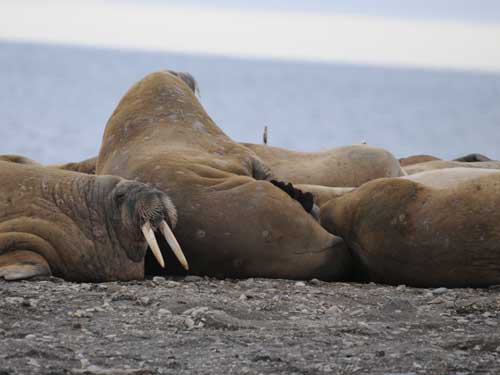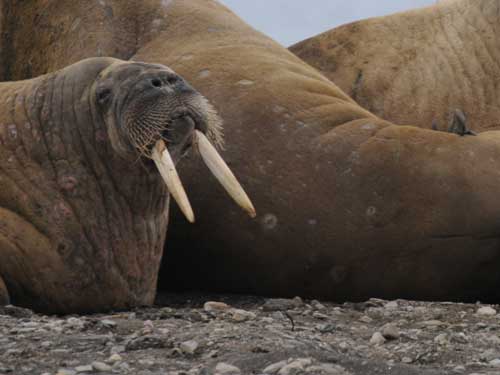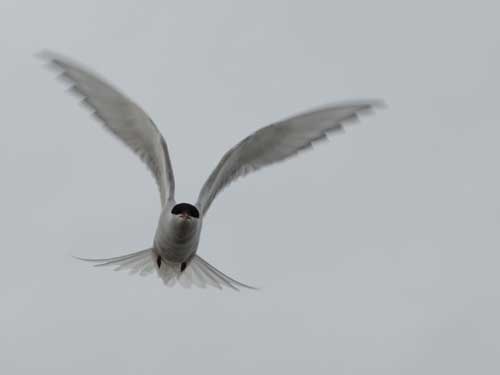Walruses! Piles of 'em!
Another sunny day -- well, they are all sunny to one extent or another, but clear sies and only a few clouds is still a notable achievement up here. Warm, too -- suprisingly so most of the time, but then the wind picks up and you go from comfortable and cozy to freezing fingers and noses.
A couple of options this morning after breakfast -- we opted for kayaking for a bit in he cove while others did short hikes to the island. The kayaks are these inflatable things, more like ight canoes than kayaks and (or so I've been told) nearly mpossible to tip over. this is important, as the hsitory of mark and I in small boats usualy ends with one of us in the water. That would be unpleasant aound here.
Once again waterproofed and layered, we ventured out in the kayak for about an hour and a half, just coasting arond the clear, cold water and enjoying the silence. The water is realy clear, and around the rocks it is shallow enough that you can see the bottom an the absndance of plants and leafy things. I always used to hate swmming in Minnesota's manh lakes when I wsw a child, becfause of the wavey frondy grippy things that would reach out and touch your toes. Freaked me out every time.
Mark and I actually paddled together, didn't yell, and managed to navigate in the directon we watned to go. This is new, actualy. Usually we go around in cirles, whack our paddles together, and argue. "These things are called kayaks, butin some dialects, they are known as 'divorce court'" We got a long lecture about the GPS transcievers and the black button upon it, that were were NOT to press, unless we were going to be eaten by an orca or polar bear or fell in the water, in which case we didn't need to push the shiny button, since it would go off on its own. He mentioend not pusing the button so often that we were nearly compelled to do so.
Yes, I am six.
We stayed out too long in the kayak nd missed the walk. No worries, there would be ample opportunity to walk later, I'm sure. Instead, we went to the national geographic photography seminar/breakout sessions to one again be reminded that our cameras are far smarter than we are. We did learn a couple of good hints on how to take picturesi n the arctic (I would not hae thought, actally, that over-exposing snow is what is necesary to get picutres of polar bears) and happily snapped bracketed images and listened to our patient photo guy explain "sport mode" to everyone with point-and-shoot cameras.
Despite the fact taht we have a fetish for high-end camera gear that frankly is beyond our skill level to use completely and know what all he button and levers an options really do, we are hopelessly outclassed in the camera and lens department on this trip. There are a few people with enormous cases with lenses the size of small missiles and five foot tripods and six camera bodies that they haul out at the slghtest possibilty of seeing someting. Mark looked over at one guy with a two-foot logn lens, looked down at our large zoom and announced that he felt entirely inadequate now. We're of the 'take lots of pictures, try to get good ones,and a few out of each hundred will be fabulous" mode of travel photography. Mark does better on the technical aspects of things than I do, I think, but I tend to do better composition of the shots. If we could only meld our brains. At least now we have two camera bodies and associated lenses, etc, so we don't have to share the camera. that was difficult for us. I'd change settings, and he'd yell. He'd set things some other way, and all my shots would be underexposed and I'd bitch. Now, we each have a camera that is "ours" and have to ask to borrow the other. I usually have the reasonably normal lens on the newer camera (Nikon d700) and he carries the older body with the huge Sigma zoom. It's almot too heavy for me to balance without a tripod, but he seems to do ok, And with the image stabilization stuff in the lens itself, it's remarkably stable and takes great pictures evenwitnout the tripod in most cases.
It's funny how there is an "us and them" rivalry between Nikon and Canon users -- we both think we have the superior camera, and will argue minutiae over which pixel count is accurate, who does better color resolution and balance, etc. It's a hoot.Everone wznts to know which camera the NG photographers use, what lenses...and w'ere all out hanging over the railing to get the perfect picture of that bird, just there....I have a bunch of shots of people taking photos, it's almot as intresting to watch all the other passengers (and me, of course!) than the scenery.
The schedule got wonked today, and they shifted dinner and the afternoon sessions to accomodate a laterl landing on Low Island, so we could see walruses. Walrus? Walrii? Any way, they have two beach sites where the males haul out of the water and bask and scratchand sleep. We opted for the short walk, since the firsto ne didn't even leae until 8:30 an the lat was scheduled for after 10. Just a quick hike of the island over squishy sand and shifting rock to watch a huddle of enormous walruses out on the rocy beach. We cant get ery close, althouh they don't really seem terribly excited about this horde of colorful humans trudging loudly up the rock path. A few lazily raised heads, a grunt or two, and they are back to sleepin and scratching. It's all males at this point -- and not the big beachmaster males, these are the young bulls and the very old (one had broken off both of his tusks) lazing about and scractching their itchy, peeling skin. That's normal this time of year, and they spend hours clustered together in big, beefy piles, napping and trying to scrape off the itchy, dry skin from overwinter
Walrus are just sort of ridiculous creatures, when you look at them. Big round bodies and tiny litle heads with luxuriant mustaches and these long tusks (really, just specialized canine teeth). They use them to dig into the ice to keep breathing holes open, to help pull themselves up onto sea ice, to fight with other walruses. The males are about 1 1/2 tons, the females about a ton or so. They are not the biggest seals, of course, elephant seals have that honor, but they are really large. And, as our naturalist guide mentioned, walruses have th longest penis in the mammal world. I'm not quite sure why that would be, but there you go.
They don't actually do much but sleep and grunt, and we quietly sidled away once we all got cold, to return to the boat in the zodiacs, with freezing ears and runny noses.


